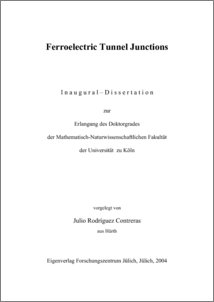Rodriguez Contreras, Julio
(2003).
Ferroelectric Tunnel Junctions.
PhD thesis, Universität zu Köln.

![[img]](https://kups.ub.uni-koeln.de/style/images/fileicons/application_pdf.png)  Preview |
|
PDF
Dissertation_Julio_Rodriguez_Contreras_v2.pdf
Download (5MB)
|
Abstract
Ferroelectricity and quantum-mechanical electron tunneling are well-known physical phenomena that have been studied for as long as a century. During this long period, scientific research has been restricted either to ferroelectricity or to electron tunneling. Never before have these subjects been combined into a new phenomenon based on their interaction. Within this work, I present the novel concept of a ferroelectric tunnel junction, where the term ferroelectric refers to a property of the barrier material. This device consists of a ferroelectric layer sandwiched between metal electrodes. The thickness of the ferroelectric layer is thin enough to allow for electron tunneling. For the first time, the influence of macroscopic parameters, such as the spontaneous polarization and strain on quantum-mechanical electron tunneling through a ferroelectric tunnel barrier is studied experimentally. In addition, the experimental work is accompanied by theoretical ideas and predictions concerning the manifestation of piezoelectricity or ferroelectricity in direct electron tunneling.
| Item Type: |
Thesis
(PhD thesis)
|
| Translated title: |
| Title | Language |
|---|
| Ferroelektrische Tunnelkontakte | German |
|
| Translated abstract: |
| Abstract | Language |
|---|
| Ferroelektrizität und quantenmechanisches Elektronentunneln sind gut bekannte physikalische Phänomene, die seit einem Jahrhundert untersucht werden. Während dieser langen Zeit beschäftigte sich die wissenschaftliche Forschung entweder mit Ferroelektrizität oder mit dem Elektronentunneln. Niemals zuvor hat eine Verbindung dieser beiden Phänomene stattgefunden und niemals ist ein neues Phänomen beobachtet worden, das auf ihrer Wechselwirkung beruht. In dieser Arbeit stelle ich das Konzept eines ferroelektrischen Tunnelkontakts vor. Der Begriff ferroelektrisch bezieht sich hierbei auf eine Eigenschaft des Barrierenmaterials. Ein solcher Tunnelkontakt besteht aus einer ferroelektrischen Schicht, die sich zwischen zwei Metallelektroden befindet. Die ferroelektrische Schicht ist dabei dünn genug, um Elektronentunneln durch sie hindurch zu ermöglichen. Zum ersten Mal wird die Wechselwirkung von makroskopischen Größen, wie z. B. der spontanen Polarisation und der Gitterverzerrung, mit quantenmechanischem Elektronentunneln experimentell untersucht. Begleitet wird die experimentelle Arbeit durch theoretische Ideen und Vorhersagen über den Einfluß der Piezo- und Ferroelektrizität auf das direkte Elektronentunneln. | German |
|
| Creators: |
| Creators | Email | ORCID | ORCID Put Code |
|---|
| Rodriguez Contreras, Julio | julio.rodriguez@web.de | UNSPECIFIED | UNSPECIFIED |
|
| URN: |
urn:nbn:de:hbz:38-12821 |
| Date: |
2003 |
| Language: |
English |
| Faculty: |
Faculty of Mathematics and Natural Sciences |
| Divisions: |
Außeruniversitäre Forschungseinrichtungen > Forschungszentrum Jülich |
| Subjects: |
Physics |
| Uncontrolled Keywords: |
| Keywords | Language |
|---|
| Ferroelektrizität , Tunnelkontakte , ferroelektrisch , tunneln , resistives Schalten | German | | ferroelectricity , electron tunneling , resistiv switching , thin films , piezoelectricity | English |
|
| Date of oral exam: |
9 November 2003 |
| Referee: |
| Name | Academic Title |
|---|
| Buchal, Christoph | Prof. Dr. |
|
| Refereed: |
Yes |
| URI: |
http://kups.ub.uni-koeln.de/id/eprint/1282 |
Downloads per month over past year
Export
Actions (login required)
 |
View Item |


